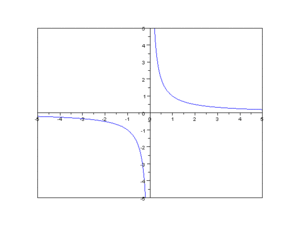Proportionality (mathematics)

In mathematics, two variables are proportional if there is always a constant ratio between them. The constant is called the coefficient of proportionality or proportionality constant.
- If one variable is always the product of the other variable and a constant, the two are said to be directly proportional. x and y are directly proportional if the ratio y/x is constant.
- If the product of the two variables is always a constant, the two are said to be inversely proportional. x and y are inversely proportional if the product xy is constant.
To express the statement "y is directly proportional to x" mathematically, we write an equation y = cx, where c is the proportionality constant. Symbolically, this is written as y ∝ x.
To express the statement "y is inversely proportional to x" mathematically, we write an equation y = c/x. We can equivalently write "y is directly proportional to 1/x".
Direct proportionality
Given two variables x and y, y is directly proportional to x[1] if there is a non-zero constant k such that
See also: Equals sign |
The relation is often denoted, using the ∝ or ~ symbol, as
and the constant ratio
is called the proportionality constant, constant of variation or constant of proportionality. This can also be viewed as a two-variable linear equation with a y-intercept of 0.
Examples
- If an object travels at a constant speed, then the distance traveled is directly proportional to the time spent traveling, with the speed being the constant of proportionality.
- The circumference of a circle is directly proportional to its diameter, with the constant of proportionality equal to π.
- On a map of a sufficiently small area, drawn to scale distances, the distance between any two points on the map is directly proportional to the length of the projected line between the two locations that the points represent, with the constant of proportionality being the scale of the map.
- The force, acting on a certain object across short distances due to gravity, is directly proportional to the object's sufficiently small mass; the constant of proportionality between the force and the mass is known as gravitational acceleration.
- The net force acting on an object is proportional to the acceleration of that object. The constant of proportionality in this, Newton's Second Law, is the classical mass of the object.
Properties
Since
is equivalent to
it follows that if y is directly proportional to x, with (nonzero) proportionality constant k, then x is also directly proportional to y, with proportionality constant 1/k.
If y is directly proportional to x, then the graph of y as a function of x is a straight line passing through the origin with the slope of the line equal to the constant of proportionality: it corresponds to linear growth.
Inverse proportionality

The concept of inverse proportionality can be contrasted with direct proportionality. Consider two variables said to be "inversely proportional" to each other. If all other variables are held constant, the magnitude or absolute value of one inversely proportional variable decreases if the other variable increases, while their product (the constant of proportionality k) is always the same. As an example, the time taken for a journey is inversely proportional to the speed of travel.
Formally, two variables are inversely proportional (also called varying inversely, in inverse variation, in inverse proportion, in reciprocal proportion) if each of the variables is directly proportional to the multiplicative inverse (reciprocal) of the other, or equivalently if their product is a constant.[2] It follows that the variable y is inversely proportional to the variable x if there exists a non-zero constant k such that
or equivalently Hence the constant is the product of x and y.
The graph of two variables varying inversely on the Cartesian coordinate plane is a rectangular hyperbola. The product of the x and y values of each point on the curve equals the constant of proportionality (k). Since neither x nor y can equal zero (because k is non-zero), the graph never crosses either axis.
Hyperbolic coordinates
The concepts of direct and inverse proportion lead to the location of points in the Cartesian plane by hyperbolic coordinates; the two coordinates correspond to the constant of direct proportionality that specifies a point as being on a particular ray and the constant of inverse proportionality that specifies a point as being on a particular hyperbola.
See also
- Correlation
- Eudoxus of Cnidus
- Golden ratio
- Proportional font
- Ratio
- Rule of three (mathematics)
- Sample size
- Similarity
- Basic proportionality theorem
Growth
Notes
- ↑ Weisstein, Eric W. "Directly Proportional". MathWorld – A Wolfram Web Resource.
- ↑ Weisstein, Eric W. "Inversely Proportional". MathWorld – A Wolfram Web Resource.
References
- Ya.B. Zeldovich, I.M. Yaglom: Higher math for Beginners. pp. 34-35
- Brian Burell: Merriam-Webster's Guide to Everyday Math: A Home and Business Reference. Merriam-Webster, 1998, ISBN 9780877796213, pp. 85-101
- Lanius, Cynthia S.; Williams Susan E.: PROPORTIONALITY: A Unifying Theme for the Middle Grades. Mathematics Teaching in the Middle School 8.8 (2003), pp. 392-96 (JSTOR)
- Seeley, Cathy; Schielack Jane F.: A Look at the Development of Ratios, Rates, and Proportionality. Mathematics Teaching in the Middle School, 13.3, 2007, pp. 140-42 (JSTOR)
- Van Dooren, Wim; De Bock Dirk; Evers Marleen; Verschaffel Lieven : Students' Overuse of Proportionality on Missing-Value Problems: How Numbers May Change Solutions. Journal for Research in Mathematics Education, 40.2, 2009, pp. 187-211 (JSTOR)